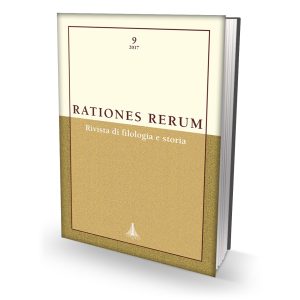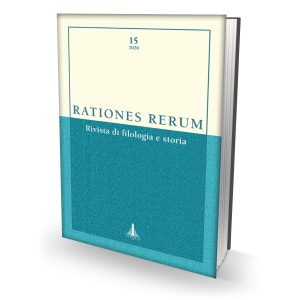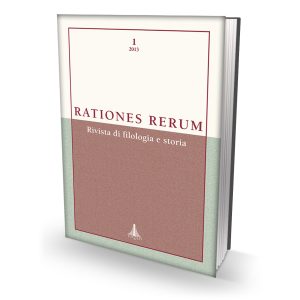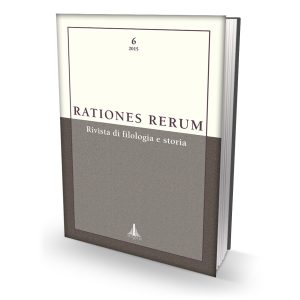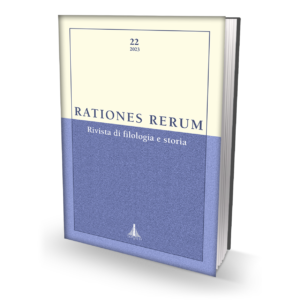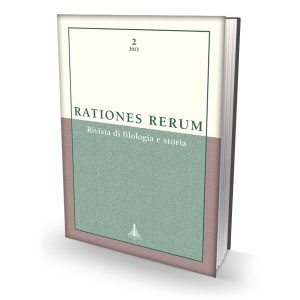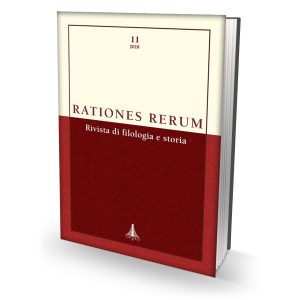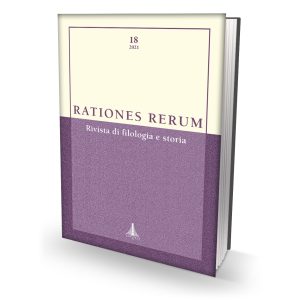RATIONES RERUM 23 – Rivista di filologia e storia
50,00 €
Autori vari
Anno edizione: 2024
Formato 17×24 – Pagine 288
Confezione a filo refe in brossura
Copertina plastificata con bandelle
ISBN 9791281673021 – ISSN 2284-2497
Prezzo: € 50,00
- Descrizione
- ANTEPRIMA
- ABSTRACTS
Descrizione
SOMMARIO
Eugenio Lanzillotta, Su un frammento della Foronide in Clemente Alessandrino, p. 9 →Estratto
Valeria Foderà, I Deucalionidi in Ecateo di Mileto (FGrHist 1 F13 e F15), p. 21 →Estratto
Giuseppe Squillace, Quali donne in profumeria? Nota a Teofrasto, De odoribus 42, p. 39 →Estratto
Vito Bruno, Il pezzo mancante. Un frammento parzialmente inedito della “grande lista” dei theorodokoi di Delfi, p. 65 →Estratto
Simona Antolini, Bilinguismo e biculturalismo nel mondo romano. Esempi e riflessioni a margine della scelta del latino nella provincia di Epiro, p. 91 →Estratto
Werner Eck – Andreas Pangerl, Eine weitere Kopie des Bürgerrechtserlasses für Moesia Inferior aus dem Jahr 146. Eine eigenwillige Schriftform für den Buchstaben H, p. 117 →Estratto
Thomas R. Martin, Courage (parastema) and ethnicity in Josephus’ Jewish War, p. 125 →Estratto
Margherita Cassia, Merce di lusso e status symbol: il pavone fra età repubblicana e tarda antichità, p. 151 →Estratto
Alessia Prontera, Per l’esegesi di Ausonio, Cento nuptialis 107, p. 175 →Estratto
Antonella Amico, Una lezione di Silvio Accame per la televisione (1970). Storia antica e «impegno culturale-didattico» in Italia al tramonto del boom economico, p. 181 →Estratto
Discussioni
Donatella Erdas, Le comunità civiche di Magna Grecia fino al V secolo a.C. tra rappresentanza politica, controllo della cittadinanza e magistrature, p. 211 →Estratto
Recensioni
Serena Bianchetti, rec. di David Lodesani, Dionisio Periegeta. Descrizione dell’ecumene. Introduzione, testo critico, traduzione e commento, Roma, Edizioni Quasar, 2022, p. 235
Rosa Maria Lucifora, rec. di Giovanni Brandi Cordasco Salmena, Nossalità, falsa nossalità e magia negli illeciti agricoli e pastorali dalla codificazione decemvirale al primo principato, Roma – Bristol, L’Erma di Bretschneider, 2023, p. 248
Andrea Marcucci, rec. di Andrea Cozzo, La logica della guerra nella Grecia antica. Contenuti, forme, contraddizioni, Palermo, Palermo University Press, 2024, p. 256
Rocco Viccione, rec. di Fabrizio Oppedisano – Paola S. Salvatori – Federico Santangelo (curr.), Costruire la nuova Italia. Miti di Roma e fascismo, Roma, Viella, 2023, p. 263
Libri ricevuti, p. 271
Abstracts, p. 275
Indice analitico (a cura di Carlo Di Giovine), p. 281
Istruzioni per gli autori, p. 285
Eugenio Lanzillotta
Su un frammento della Foronide in Clemente Alessandrino
pp. 9-19
In the Stromata (1, 102, 1-103, 1), Clement of Alexandria lists the oldest royal dynasties of the Greek world: occupying the premier rank is Argos, whose first king is said to have lived twenty generations after the beginning of the Assyrian kingdom. During the reign of the second king of Argos, Phoroneus, the dynasties of the kings of Sicyon and Crete would have begun; while the first king of Attica, Cecrops, would have come to power three generations after Phoroneus. Clement explicitly argues that the Greeks cannot claim any chronological primacy over other peoples, since the Assyrians would have provided for themselves monarchical institutions long before them, and of course even more ancient, according to universal agreement, was the Egyptian kingdom. Clement, in the same passage, also quotes Dionysius of Halicarnassus. For both, Phoroneus is the progenitor of the Greek lineages, but they evaluate his figure differently: Dionysius, who probably follows an Arcadian tradition, merely reports that Phoroneus had been the first king of a Peloponnesian polis; Clement, in addition to emphasizing his personal antiquity and kingship, points out that for the poet of the Phoronis (c. 7th – 6th century BC) and for Acusilaus (that is, for the Argive tradition) Phoroneus would have been “the father of mortal men”, i.e., the first man. The article discusses the complex problems of Greek genealogical traditions, with an excursus on the Áτλαντικò λόγο that Plato (Tim. 21c) fictionally attributes to the great Athenian lawgiver Solon.
Valeria Foderà
I Deucalionidi in Ecateo di Mileto (FGrHist 1 F13 e F15)
pp. 21-37
This article analyzes two fragments from Hecataeus of Miletus (FGrHist 1 F13 and F15) that describe the genealogy of Deucalion. They provide an alternative lineage in which the sons of Deucalion are Pronoos, Orestheus, and Marathonios, and contrast with the Hesiodic Catalog of Women, reflecting broader themes of ethnic identity and mythological evolution within Greek historiography. The analysis highlights the distinctive nature of Hecataeus’ version, suggesting the existence of a deeper link between his genealogy and the local traditions of Aetolia and Attica. This study argues that these genealogical adaptations were influenced by regional identities and their e orts of historical reorganization.
Giuseppe Squillace
Quali donne in profumeria? Nota a Teofrasto, De odoribus 42
pp. 39-63
In the treatise De odoribus (§ 42), Theophrastus, reporting information taken from Athenian myrepsoi and myropolai, lists the perfumes for men and those for women. Among the latter, preferred for their strength and persistence, he includes the myrrh stakte, the Megaleion, the Aigyption, the amarakinon, and the nardinon – refined and very expensive fragrances within the reach of rich buyers only. Starting from Theophrastus’ passage, this article questions how perfumes were chosen and purchased by free, married, and wealthy Athenian women who, according to our sources, spent their days in the gynaeceum, showing themselves in public only on the occasion of religious festivals and funerals.
Vito Bruno
Il pezzo mancante. Un frammento parzialmente inedito della “grande lista” dei theorodokoi di Delfi
pp. 65-90
The “Great List” of Delphi is the most important of the eight catalogs of theorodokoi known so far. It is engraved on a stele composed of twelve fragments. This article describes the circumstances of its discovery and publication, dwelling, in particular, on the text of the last catalog, of which it provides the editio princeps of the left side. Finally, a hypothesis is formulated on how the Great List was compiled between the late 3rd and early 2nd centuries BC.
Simona Antolini
Bilinguismo e biculturalismo nel mondo romano. Esempi e riflessioni a margine della scelta del latino nella provincia di Epiro
pp. 91-116
This article discusses bilingualism in Epirus, an area of cultural interference and linguistic hybridity on the border between the Western (Latin) and Eastern (Greek) worlds. The geographical and chronological extents of Latin epigraphy are investigated in order to identify the patterns and characteristics of Latin usage in a context that remained essentially Hellenophone, resisting Roman cultural penetration.
Werner Eck, Andreas Pangerl
Eine weitere Kopie des Bürgerrechts-erlasses für Moesia Inferior aus dem Jahr 146. Eine eigenwillige Schriftform für den Buchstaben H
pp. 117-124
A further copy of a constitution is published, which was issued by Antoninus Pius in 146 for the troops in Moesia inferior under the governor Claudius Antoninus. The text of the diploma is identical to other copies of the same constitution; the name of the prefect of the cohors Bracarum Claudius Valerius Frontinus and the name of the recipient of the diploma are new. The fact, that the letter H appears in a striking form, is unusual.
Thomas R. Martin
Courage (parastema) and Ethnicity in Josephus’ Jewish War
pp. 125-149
This article argues that Josephus uses the rare Greek word παράστηµα (here translated as “courage”) in the narrative of the climax of the Roman assault on Jerusalem in his Jewish War to suggest a contrast between, on the one hand, non-elite ethnically Roman soldiers, and, on the other hand, Jews, ethnically non-Roman auxiliary soldiers, Vespasian, and Titus. Using this term more often than any author before him, Josephus describes non-Romans as displaying outstanding παράστηµα in combat, while their Roman comrades in the ranks conspicuously fail to do so.
Margherita Cassia
Merce di lusso e status symbol: il pavone fra età repubblicana e tarda antichità
pp. 151-173
As shown in the Edictum de pretiis, promulgated in 301 by Emperor Diocletian, the peacock, traded as much for its meat as for its feathers, at the threshold of the fourth century represented the most highly valued galliform bird on the market. Large-scale breeding of this bird – now in fact found in the wild state only in India, but essentially domestic throughout the world – is attested with certainty as early as the first century B.C. and had an aesthetic and ornamental purpose, at least in the case of male specimens (the only ones connoted by the well-known splendid plum-age), but it undoubtedly generated precise economic objectives, since the animal was not only slaughtered because of the highly sought-after meat used in the making of re ned dishes to set luxurious tables (including those of emperors) and for the characteristic, highly prized, ocellated feathers (used to make fans, flyswatters or for ceremonial purposes), but it was also sold alive for the production of eggs, intended for both reproductive and food purposes.
Alessia Prontera
Per l’esegesi di Ausonio, Cento nuptialis 107
pp. 175-179
This article examines the second hemistich of v. 107 of Ausonius’ Cento nuptialis, on which critics have often been divided. The expression pedibus per mutua nexis would be part of the description of the husband s phallus during the wedding night and not of the description of the intertwined bodies of the newlyweds. Its tangential connection with Proba’s Cento Vergilianus would no longer be explicable as a parodic allusion to this Christian writing.
Antonella Amico
Una lezione di Silvio Accame per la televisione (1970). Storia antica e «impegno culturale-didattico» in Italia al tramonto del boom economico
pp. 181-208
The great historian Silvio Accame (1911-1997) gave three lectures for the Italian national television (RAI) on behalf of the Ministry of Education: the first on Demosthenes (1968), the other two on myth in ancient Greece and on Greek society, both in 1970. This article presents the lesson on myth, from whose evolution under the influence of doubt, according to Accame, historical criticism is born. Some documents allow us to reconstruct the context in which the lecture was aired and the scholar s subsequent reaction.
Donatella Erdas
Le comunità civiche di Magna Grecia fino al V secolo a.C. tra rappresentanza politica, controllo della cittadinanza e magistrature
pp. 211-233
Between the 6th and 5th centuries BC, many Greek colonies of Magna Graecia explored new forms of political and institutional organization, while others ceased to exist as poleis. The political and institutional experiences and the civic arrangements they assumed over time were conditioned by their history and took different forms as a result. Although the unevenness of the sources makes it difficult to propose uniform interpretative models for the cities of Magna Graecia compared, for example, to the Sicilian poleis, features of contiguity can nevertheless be identified, even among apoikiai of different origins. This article proposes some reflections on the political experiences of Magna Graecia up to the 5th century BC, especially in relation to forms of political representation, control of citizenship, and some magistracies.







